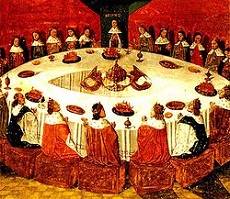July 12, 2013
Round meeting tables enhance workplace consensus and collaboration
The Knights of the Round Table may be the stuff of legend but it seems King Arthur was on to something, for a new study reveals that people sitting in a circular formation at round meeting tables are more likely to want to ‘belong’ to a group and are less prone to be antagonistic. By contrast, the research from the University of British Columbia’s Sauder School of Business found that people seated in an angular arrangement – i.e. “The Boardroom” in Sir Alan Sugar’s The Apprentice – are more likely to look out for number one. “The geometric shape of a seating arrangement can act as a subtle environmental cue for people, by priming their fundamental need for inclusiveness or individuality,” says Sauder Assistant Professor Juliet Zhu, who co-authored the forthcoming study to be published in the Journal of Consumer Research.
In a series of experiments for the study, volunteers were asked to sit in either circular or angular seating plans and were then asked to evaluate advertisements.
They found that those sitting at circular or oval meeting tables reacted more favourably towards ads that conveyed a sense of belonging, showing groups of family members or friends.
In contrast, participants seated in rectangular formations identified more with ads portraying go-getting individuals – “maverick” types.
Zhu added: “Seating arrangements can potentially influence people in a variety of situations, whether they are at work or at a big family gathering, or in consumer setting such as restaurants, hotel lobbies, airports, or on public transit.”
The study, “The Geometry of Persuasion: How Do Seating Layouts Influence Consumers, was co-authored by Assistant Professor of Marketing, Rui Juliet Zhu from the Sauder School of Business and Professor of Marketing, Jennifer J. Argo from the University of Alberta.














July 12, 2013 @ 10:10 am
I’ve always been a big advocate of circular tables for meeting rooms so this research is very pleasing to hear!